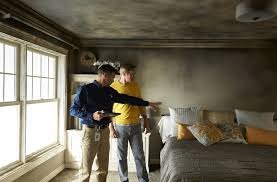Essential Steps to Take When Flood Damage Strikes: A Homeowner’s Checklist

Introduction
Flood damage can be one of the most overwhelming disasters a homeowner can face. Whether caused by a natural disaster, a burst pipe, or a malfunctioning appliance, floodwater can wreak havoc on a home within minutes. Acting quickly and efficiently in the face of flood damage is crucial to minimizing destruction and protecting your property. Knowing what to do in these critical moments can save you from costly repairs and long-term complications like mold and structural damage.
This article offers a comprehensive, step-by-step guide for homeowners on how to respond effectively to flood damage. From ensuring safety to taking proactive steps for flood damage restoration, this checklist will help you navigate the challenges of flooding with confidence.
Step 1: Ensure Safety First
Before jumping into any action, the most important step is ensuring your and your family’s safety. Floodwaters can bring a host of hazards, including electrical risks, contamination, and structural instability.
- Turn Off Power: Water and electricity are a deadly combination. If it’s safe to do so, turn off the electricity at the main breaker to avoid potential electrocution. If you can’t safely reach the breaker, leave the home immediately and call a professional.
- Avoid Contaminated Water: Floodwaters often carry harmful bacteria, chemicals, and debris, especially if they are from a sewage backup or external flooding. Avoid wading into the water unless you are wearing protective gear.
- Assess Structural Stability: Floods can compromise the integrity of walls, floors, and roofs. If you notice buckling, sagging, or cracking, leave the home and have a professional inspect the damage before re-entering.
Once you’ve ensured that everyone is safe, you can move forward with managing the flood damage and initiating the restoration process.
Step 2: Document the Damage for Insurance
After ensuring safety, the next important step is to document the damage for insurance purposes. Proper documentation will make the claims process smoother and ensure you receive the compensation you need for repairs.
- Take Photos and Videos: Capture clear, detailed images of all affected areas. This includes standing water, damaged furniture, floors, walls, and personal items. Make sure to document both close-up and wide-angle shots to give a full perspective of the damage.
- List Damaged Items: Create a list of all personal belongings that have been damaged by the flood. Include important details such as purchase dates, values, and any relevant receipts if available.
- Contact Your Insurance Provider: Reach out to your homeowner’s insurance company as soon as possible to report the damage. They will guide you through the claims process and send an adjuster to assess the extent of the damage.
Having thorough documentation can expedite the claims process and ensure that you receive adequate compensation to cover the cost of repairs.
Step 3: Begin Water Removal and Drying
Once the initial assessment is complete, it’s time to start removing water and drying out the affected areas. This is one of the most critical steps in flood damage restoration, as stagnant water can lead to secondary damage like mold growth and structural weakening.
- Remove Standing Water: Use buckets, mops, and wet/dry vacuums to remove as much standing water as possible. For larger amounts of water, submersible pumps may be necessary.
- Ventilate the Area: Open windows and doors to promote air circulation. This helps speed up the drying process and prevents further moisture buildup.
- Use Dehumidifiers and Fans: Once the standing water is removed, the drying process continues with the use of high-powered fans and dehumidifiers. These tools will help remove any lingering moisture from the air and materials like carpets and walls.
- Remove Damaged Items: Carpeting, furniture, and personal items that are soaked in floodwater may need to be removed to prevent further damage and mold growth. If items can be salvaged, move them to a dry area and begin the cleaning process.
For larger flood incidents, it’s best to rely on restoration experts who have the equipment and experience to handle extensive water damage effectively.
Step 4: Prevent Mold Growth
Mold can begin to develop within 24-48 hours of water exposure, making it one of the most significant risks following a flood. Mold not only causes structural damage but can also pose severe health risks, particularly for individuals with respiratory issues or allergies.
- Inspect for Signs of Mold: Mold may appear as black, green, or white spots on walls, floors, and ceilings. However, not all mold is visible, so pay attention to musty odors that can indicate hidden mold behind walls or under carpets.
- Remove Water-Damaged Materials: Items like drywall, insulation, and flooring that have been soaked may need to be removed entirely. These materials can harbor moisture, creating the perfect environment for mold growth.
- Use Mold-Resistant Products: When replacing materials, opt for mold-resistant drywall and insulation to reduce the risk of future mold problems.
If you suspect a significant mold issue, it’s best to contact restoration professionals like Dry Pros to handle mold remediation safely and thoroughly.
Step 5: Begin Restoration and Repairs
Once the water is removed and the space is dry, it’s time to begin the restoration process. Depending on the severity of the flood, this can range from minor repairs to complete structural rebuilds.
- Assess Structural Damage: Have a professional inspect your home’s foundation, walls, and roof for any structural damage caused by the flood. If water has weakened any essential components, repairs will need to be made immediately to prevent future issues.
- Replace Flooring and Drywall: In many cases, flooring and drywall will need to be replaced entirely. Carpets, wood flooring, and laminate are particularly vulnerable to water damage and mold growth.
- Repaint and Refinish: Once repairs are complete, repaint walls with mold-resistant paint and refinish flooring if needed.
Professional flood damage restoration services, like those provided by Dry Pros, can ensure that the repairs are done to the highest standards, restoring your home to its pre-flood condition.
Step 6: Take Preventative Measures
After recovering from flood damage, it’s essential to take steps to prevent future flooding. While natural disasters can’t always be avoided, there are preventative measures you can take to minimize the risk of future water damage.
- Install a Sump Pump: A sump pump is one of the most effective tools for preventing flooding in basements or low-lying areas. Make sure it has a backup power source in case of outages during storms.
- Inspect and Clean Gutters: Blocked gutters can cause water to pool around your home, increasing the risk of flooding. Clean gutters regularly and ensure that downspouts direct water at least 3 feet away from your foundation.
- Seal Cracks in Your Foundation: Inspect your foundation for any cracks or gaps where water might enter. Seal them with waterproof materials to prevent leaks.
- Consider Flood Insurance: If you live in a flood-prone area, consider purchasing flood insurance. Standard homeowner’s insurance policies often do not cover flood damage.
Conclusion
Flood damage can feel overwhelming, but by following these essential steps, homeowners can take control of the situation and minimize long-term damage. From ensuring safety to enlisting professional flood damage restoration services, each step in this checklist is designed to help you recover as quickly and efficiently as possible. By acting swiftly and prioritizing restoration, you can restore your home and prevent future issues caused by flooding.



